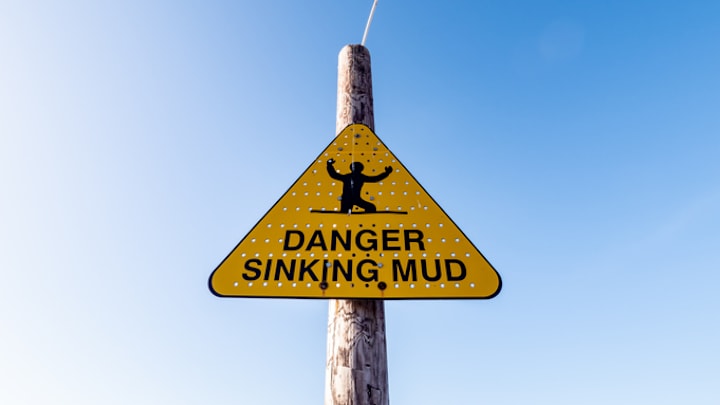Quicksand has a lethal reputation: a surprisingly high percentage of movie villains drown in it, and quite a few heroes have saved a damsel in distress from a silty, sloppy end. But quicksand is much more complex than Hollywood would have you believe. Here’s a rundown of the facts about the mysterious muck.
1. Technically, quicksand is a colloid.

Most quicksand is a viscous mixture of sand, clay, mud, or silt saturated with water. Scientifically speaking, it’s a colloid—a situation in which one substance (sand or silt) is suspended in another substance (water) without settling to the bottom. As long as the colloid stays still, the particles remain where they are. When the colloid is agitated by something—say, a person stepping into it—the mix becomes a liquified soil that can no longer support weight. Anything on the surface of the quicksand will begin to sink.
2. There are two kinds of quicksand.
Wet quicksand is the kind in which sand is suspended in water. Dry quicksand occurs when very fine sand particles are suspended in air instead of a liquid. This low-density combination, created in a lab experiment and published in the journal Nature in 2004, instantly swallowed up an object placed on its surface [PDF]. It isn’t clear where and how much dry quicksand actually exists, though likely locations would be in deserts and at the bases of sand dunes, where air can flow among the fine grains.
3. Quicksand can form anywhere the conditions are right.
For quicksand to form, conditions must be perfect: There needs to be a quantity of grainy soil and a constant water source that saturates the ground. Common locations for quicksand include beaches, lakeshores, riverbanks, marshes, and the ground surrounding subterranean springs. The low-lying river estuaries of Florida and the Carolinas are prone to quicksand, while the canyons of southern Utah, New Mexico, and northern Arizona can harbor quicksand when it forms around springs.
4. Earthquakes can bring on quicksand-like conditions.
When a significant earthquake hits, its motion can make loose, dry soil act like a liquid, a phenomenon called liquefaction. The sand or soil can be ejected from the ground and destabilize the surface, so any buildings resting there will start sinking, much like the action of quicksand. That’s exactly what happened in June 1964 when a magnitude 7.6 quake struck Niigata, Japan. Relatively few people were killed or injured, but widespread liquefaction damaged or destroyed almost 15,000 homes.
5. Quicksand made an early appearance in the movies.
Quicksand has been a movie trope almost since the advent of cinema. The first victim rescued from quicksand’s boggy clutches was a woman in Saved from The Quicksand (1909), a 12-minute film by the leading French studio Gaumont. In the film, a group of monks rescues the main character and she ends up having a kind of religious epiphany. The heyday for using quicksand as a dangerous plot point lasted from the 1940s through the '60s, and in that latter decade, 3 percent of films, or one in 35, featured quicksand, according to an analysis in Slate.
6. An Academy Award-winning film includes a famous quicksand scene.
The 1962 epic Lawrence of Arabia won seven Academy Awards, including Best Picture and Best Director. One of its memorable scenes features a boy getting swallowed by quicksand during a sandstorm (his camel survives) as T.E. Lawrence (Peter O’Toole) and Sherif Ali (Omar Sharif) struggle to save him. Hollywood screenwriters used the same plot device in Star Wars (1977); The Princess Bride (1987), in which Buttercup (Robin Wright) sinks within seconds; Jumanji (1995), where Robin Williams’s character is stuck up to his chin in the stuff; and many more.
7. It probably won’t kill you.
At first glance, quicksand appears solid. You won’t know you’re caught in it until you stumble into it. After you step or fall in, the overall density of the quicksand changes; the suspended particles sink to the bottom while water rises to the surface. This shift prevents people from sinking all the way in and gives them a chance to try to free themselves from the heavier, denser sand.
It’s extremely rare, but people have succumbed to other forces—hypothermia, dehydration, or drowning—when they’ve been unable to extricate themselves from quicksand. In May 2023, Illinois college student Zachary Porter became stuck waist-deep in muddy quicksand in Alaska’s Turnagain Arm and drowned when the tide came in, despite first responders’ efforts to free him.
8. You can survive quicksand by staying calm and lying on your back.
If you happen to step into quicksand, the first thing to do is get rid of your backpack or other heavy items on your person—and don’t panic. Then, lie on your back and spread your limbs; like a snowshoe, your body’s larger surface area will prevent you from quickly sinking into the soft sand. Begin slowly moving your legs to churn up the sand and bring the water to the surface, which should make it easier to float and extract yourself from the muck. Having a cellphone to call 911 and a buddy with a rope or stout pole wouldn’t hurt, either.
